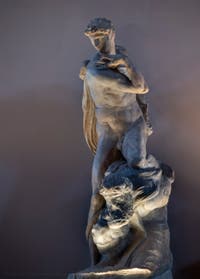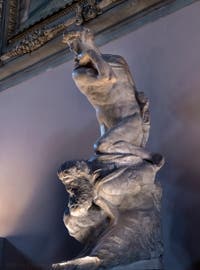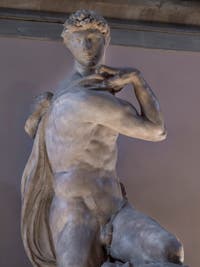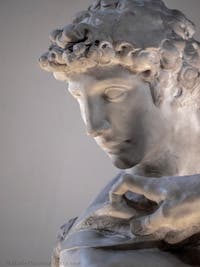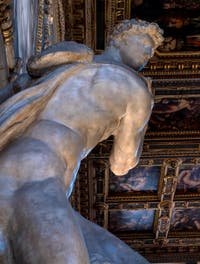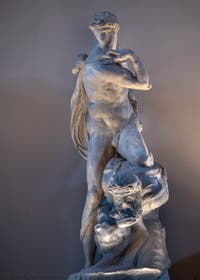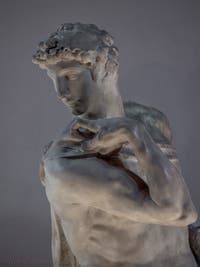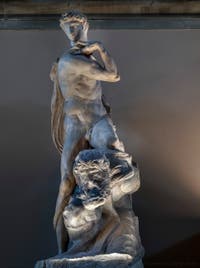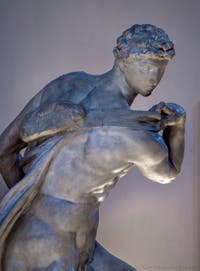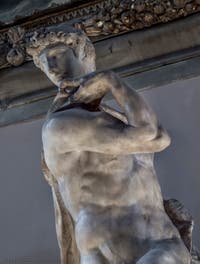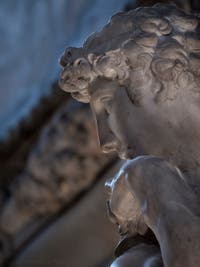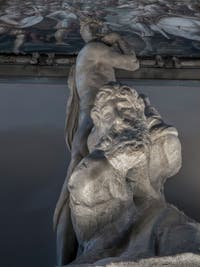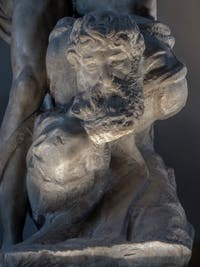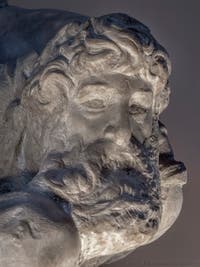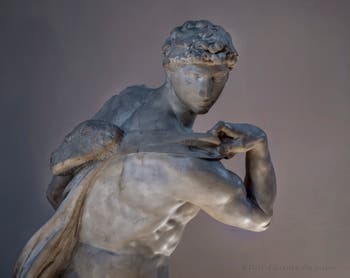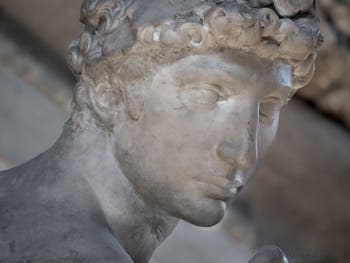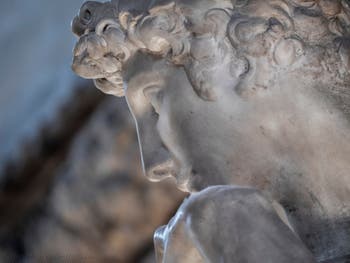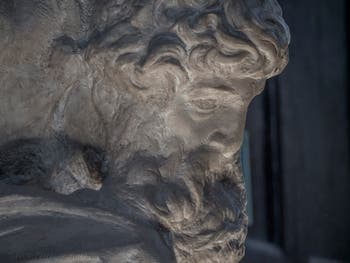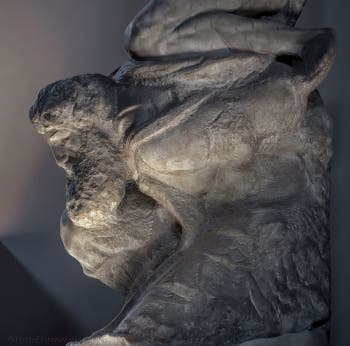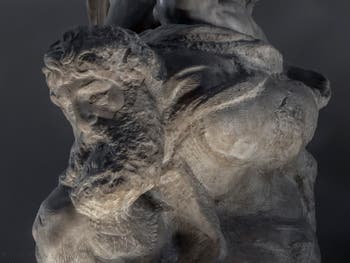Palazzo Vecchio Art Story | Location | Opening Hours Tickets | Authorizations
Art Story Five-Hundred | Tower | Vasari Halls | Dante Mask | Ghirlandaio | Bronzino Sarto Daddi | Salviati | Cortile
Five-Hundred Hall Hall and Ceiling | Ceiling Paintings | Pisa War | Siena War | Sculptures
Sculptures Michelangelo | Giambologna | Vincenzo de Rossi
Michelangelo “The Genius of Victory” or “The Winner” Palazzo Vecchio in Florence, Italy
Marble - Height 261 cm - 1530-1534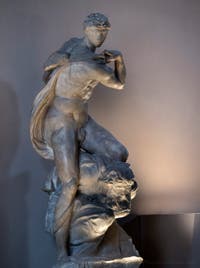
Genius of Victory This remarkable sculpture by Michelangelo, reminiscent of his “David” of the Accademia, is located in the Hall of Five Cents of Palazzo Vecchio, right in front of the “Triumphant Virtue of Vice” carved by Giambologna.
We find here the arm folded back and the hand on the shoulder, hair and face of the “David” of Florence's Accademia.
However, the winner's head's proportions are lower than they should be concerning this young man's athletic bust.
In contrast, the proportions of the head of the “David” were more considerable relative to the rest of the body.
Initially, the “Genius of Victory” was carved to be part of Pope Julius II's tomb, a superb project that was never realized for two reasons.
First of all, it would have been necessary to enlarge the Basilica of St. Peter in Rome to accommodate a tomb of this size, which was never carried out.
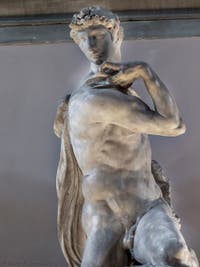
Genius of Victory And because Julius II's heirs had not acted on it, given the cost necessary for its realization.
The project was forsaken.
The statues already made or in progress remained in the state in Michelangelo's Florentine workshop, including this one and the four sculptures of the “Slave Prisoners” that you can admire at the Accademia Gallery Florence.
Michelangelo's nephew, Leonardo, had initially considered placing this statue at the top of the sculptor's tomb in the Church of Santa Croce in Florence.
Having learned of this project, Giorgio Vasari told Leonardo that the use of this winner's statue for Michelangelo's tomb might seem inappropriate since Michelangelo had never been a soldier or winner of any fight, better using the statue of La Pietà for him.
Convinced by Vasari's arguments, Michelangelo's nephew, therefore, offered this “Genius of Victory” to Duke Cosimo I of Medici to be placed in the Hall of Five Cents of Palazzo Vecchio, which was done in December 1565.
According to Pope Julius II’s tomb's plans, this sculpture was inside a niche, which explains why its sides were barely sketched.
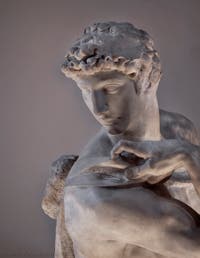
Genius of Victory This “Victory Genius” carries large oak leaves in his hair, symbolizing Pope Julius II's surname “Della Rovere”. Della Rovere means of Oak.
As for Michelangelo's choice to represent his winner, it is interesting to note the age opposition between the winner and the defeated.
Youth is triumphant while old age is a prisoner, picked down at his feet and folded in half, with his back crushed under the young man's knee.
This representation of Michelangelo's “Victory” takes place just after the battle; it is already over; this is the moment of triumph of the winner submitting the defeated.
The man is represented in armour and dressed in a wool coat, the Greek Chlamydia, his arms are tied in his back.
The defeated is folded in half, and he has no chance of escaping.
The winner crushes his weight, helped by his knee and a folded leg; his grip is part of the past.
This young athlete gazes already towards the distant, ready to challenge future enemies.
This feeling is enhanced by the young man's dynamic attitude, twisting bust, shoulder forward, arms ready to fight again.
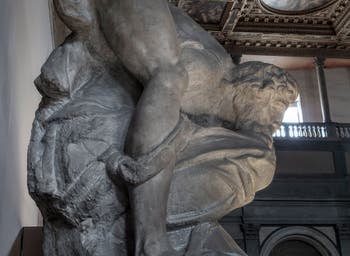
Genius of Victory The warrior's muscular nudity reinforces this expression of power compared to the defeated, dressed in unnecessary armour that could not protect him.
The dressed contrast between the two men further strengthens the dynamism and vitality expressed by the victor's bodily attitude.
We must also observe the faces' expression; the defeated suffering and depth of the gaze show him wiser and more humane than his young victor, whose face breathes determination solely.
The fact that this statue of the “Genius of Victory” was destined for the tomb of Pope Julius II explains the choice of Michelangelo, who, while associating age with a form of defeat at the end of our life, gives it more wisdom and intellectual value than to a youth deprived of prudence.
Sculptures Michelangelo | Giambologna | Vincenzo de Rossi
Five-Hundred Hall Hall and Ceiling | Ceiling Paintings | Pisa War | Siena War | Sculptures
Art Story Five-Hundred | Tower | Vasari Halls | Dante Mask | Ghirlandaio | Bronzino Sarto Daddi | Salviati | Cortile
Palazzo Vecchio Art Story | Location | Opening Hours Tickets | Authorizations
Back to Top of Page


